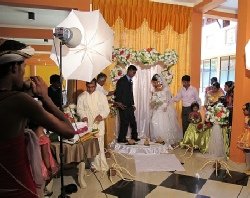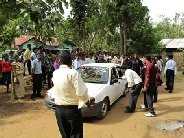© 2023 Dr. Margaret Sheppard
I attended several weddings during the years of research. Sometimes I observed from beginning to end or a part of the lengthy proceedings, but they all followed a similar pattern. The first part of the wedding -
The day will be chosen by the astrologer who gives the lucky times for the different parts of the ceremony e.g. when the bride steps out of the room where she is preparing (elaborate hairstyling, make-
Dowries are still common and there will have been lengthy negotiations between the families of the requirements for the bride's family to provide – usually household furniture, money, jewellery etc.
The first part of the wedding is held at the bride's home. For days before the family and neighbours will have been preparing the wedding feast – refreshments on arrival for the groom's family and then the “wedding breakfast” following the wedding ceremony when the bride and groom sit together and eat their first meal together as a married couple.
A person who is well versed in the Buddhist wedding ceremonies recites/chants the marriage ceremony with the groom and bride standing up together on the elaborately decorated wedding dais. The bride is dressed in a white sari and golden jewellery. They each have their own bridesmaids, flower boys and girls, best man etc. who stand to either side.
During the ceremony the right thumb of the groom is tied to the left thumb of the bride with a white thread and drops of yellow root water is poured over their joined hands from a brass pot. The groom places the wedding ring on the bride's left hand and the bride places his on his right hand. The groom will place a gold “wedding” necklace around the bride's neck.
During another part of the ceremony the groom is presented with a new white sheet by the bride's mother which he then ties around the waist of the bride. This is the sheet they will sleep on for their first night and should show proof to his relatives that she is a virgin. (In the old days if this proof was not available then she would be returned to her family in disgrace.) Then all the guests come to congratulate the newly married couple.
If they have not already been through a civil ceremony this is usually the point where it will be performed by the Registrar.
Then follows the wedding meal. This is followed by speeches from both sides who seem to compete with each other to speak at length. There may also be speeches from eminent local leaders. Wedding presents are then presented to the couple.
Then follows “together dancing” when the couple lead off the dancing and the two families intermingle with each other in the dancing.
There is a prescribed lucky time for the groom's family to leave with the bride. She is taken by them either to a hotel for the first night or to her new home. She is welcomed at her new home. Some of her relatives may accompany her to see her safely settled in. They are served with refreshments and then depart for their homes. Again there are lucky times for the couple to step over the threshold of their new home.
The next day the whole process (without the wedding ceremony) is repeated again at the groom's home. This time the bride is dressed in a red sari and all her preparation and clothes are provided by the groom's family. At a prescribed lucky time the bride's family arrive to be entertained by the groom's family. They arrive with the dowry which is unpacked into the bride's new house.
During the next 2-
After this period she usually returns for a short visit to her own home as a newly married woman.
Her first child will be born at her own home with her mother taking care of her. Subsequent children are born at her new home where she will be under the care of her in-

Weddings

